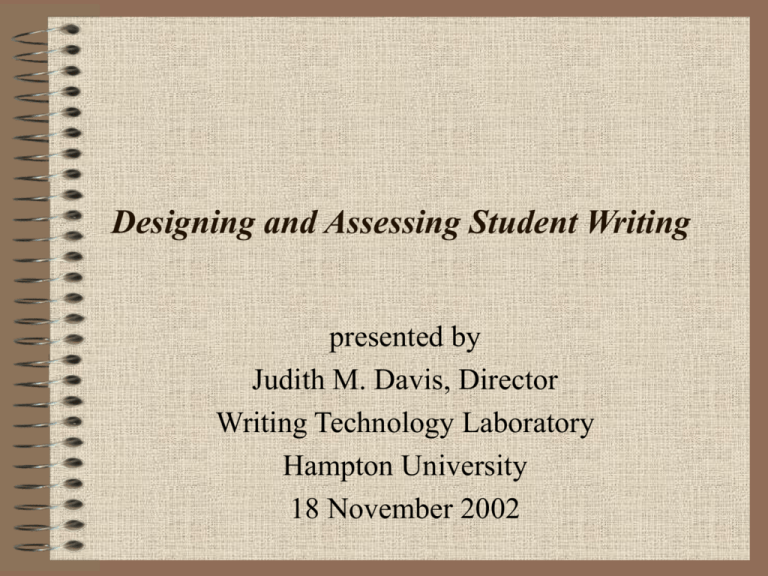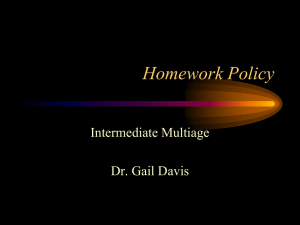Designing and Assessing Student Writing
advertisement

Designing and Assessing Student Writing presented by Judith M. Davis, Director Writing Technology Laboratory Hampton University 18 November 2002 Why write? • Are students writing to learn? Or are students writing to demonstrate knowledge? • What are the goals and objectives of the course? How will the writing assignment fit those goals and objectives? • How much writing, what types of writing, and what specific assignments will help the student to achieve those objectives? What are the goals and objectives? • • • • • Hampton University School Department Course Assignment What are the purposes for writing? • Writing to learn • Writing to demonstrate knowledge • Writing to produce “polished” products What types of writing? • • • • • • • • abstracts case studies essays “research” papers “term” papers lab reports articles reading responses • • • • • • • • journals literature reviews scripts arguments analyses instructions process descriptions essay tests How do writers write? Fluency Form Correctness What are levels of cognitive demand? • What is the students’ level of content mastery? • Through what cognitive levels must the students pass in order to complete the assignment? • How can assignments be broken down and sequenced to lead students through successive levels of cognition? Bloom’s Taxonomy (lower order thinking skills) • Knowledge level – Define, describe, distinguish, identify, indicate, list, recall, show, state, tell • Comprehension level – Compare, conclude, contrast, demonstrate, differentiate, estimate, explain, illustrate • Application level – Apply, construct, develop, plan, solve, test Bloom’ Taxonomy (higher order thinking skills) • Analysis level – Analyze, classify, discriminate, distinguish, explain, recognize, support • Synthesis level – Create, derive, develop, formulate, propose, suggest, synthesize • Evaluation level – Choose, decide, defend, evaluate, judge, select How can I get the writing I want? • Define goals and objectives. • Break large projects into smaller writing assignments. • Sequence assignments to correspond to students’ increasing mastery. • Remember that all writing does not have to be graded. Plan some assignments that allow students to “write to learn.” How can I get the writing I want? • Schedule dates for preliminary assignments leading up to a large project. • Consider how the project(s) will be evaluated (both as individual assignments and in the broader context of the course grade). • Put your assignments in writing and include evaluation criteria on the assignment sheet. How can I use feedback to help students to grow as writers? • Distinguish between formative and summative feedback. – Formative • use for journals, informal writing, ungraded assignments, and drafts • focus on content, organization, and development – Summative • use for final drafts and major projects • focus on content, as well as style and mechanics • Always point out the best part of the writing. How can I get the writing I want? • To address difficulty in the writing, first determine the student’s stage of development in relation to the project: – fluencyformcorrectness • Address global concerns like organization and development before local problems like style and mechanics. • Realize that all errors are not created equally. How can I get the writing I want? • Use a three-tiered system for comments: – identify the problem – explain the problem – offer several options for revision • Be sure that summative comments (and the grade) fit the evaluation criteria spelled out in the assignment sheet. • Use a rubric that makes the evaluation clear. Tools for effective feedback • • • • • • • Assignment sheet Preliminary writing and planning sheets Peer review sheets Self-evaluation instruments Formative comments on preliminary drafts Clear, summative comments on final drafts Grading rubrics Checklist for essay exam questions • What knowledge is the questions designed to test? • What is the relationship between the test question and other writing assignments in the course? • How will responding to the question enhance the students’ learning? Checklist for essay exam questions • Is the question phrased clearly? Does it use verbs to indicate desired method of development? • Is the students’ knowledge level in the course consistent with the cognitive level implied by the question? • Do students have adequate time to answer the question? • Are evaluation criteria clearly specified? Sample Assignment Sequence • Readings or content material • Assignment sheet • Preliminary writing assignments – exploratory writing – library research project • • • • Preliminary draft/peer review/formative feedback Revision plan/exercises/conference Self-evaluationrubric Final draft/summative feedbackrubric English 218--Instructions • Readings on collaborative writing, audience analysis, graphic design, and instruction writing • Audience and task analyses • Assignment sheet review • Daily memos • Rough draftuser testingguided peer review and formative instructor feedback • Final draftself evaluation/summative instructor feedback (both with rubrics)

![Submission 68 [doc]](http://s3.studylib.net/store/data/008000926_1-fed8eecce2c352250fd5345b7293db49-300x300.png)

